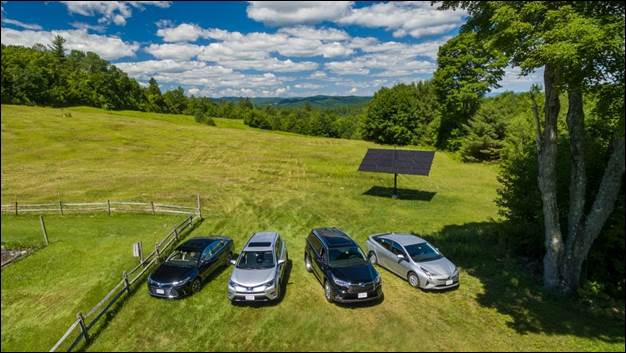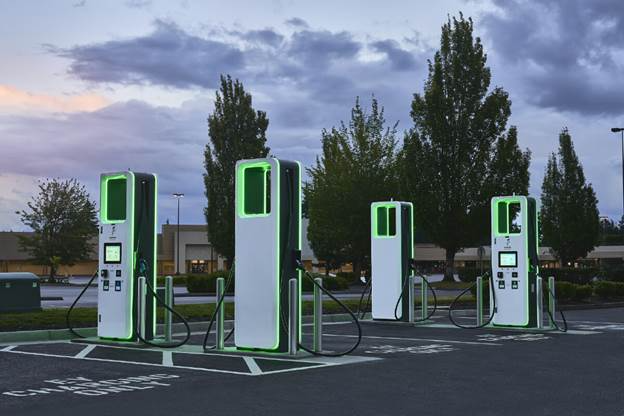
One of the biggest questions owners of electric vehicles face is how to keep their EV batteries charged. As a (conservative) rule of thumb, each mile of EV driving consumes about 1/3rd of a kilowatt-hour of battery power. That means you need about 3,333 kWh of EV battery charging for each 10,000 miles you drive. While public charging stations are becoming a more convenient and viable option in our area, charging at home with a Solaflect Tracker is still your best bet. Here’s why:
- Our backyard Tracker locks in a 25-year supply of “homemade solar fuel” at a price equivalent of roughly 75 cents a gallon.
- It takes only about a third of the annual output of one of our solar Trackers to supply 10,000 miles of EV driving. That leaves plenty of power leftover to supply other household electrical needs.
- Solar charging at home works with your daily schedule and doesn’t require long stops at public charging stations that can be many miles away.
- And, finally, most public charging stations cost more to use and are only as clean as the grid they rely on.
Our backyard Trackers outlast most electric vehicles with 20,000 miles of affordable EV driving every year for 25 years
In short, our Trackers are the perfect backyard replacement for the nearest gas pump and can be part of a home charging station that runs on 100% pure, unadulterated sunshine! Read on if you’d like to learn more about the benefits of backyard solar and in-garage charging.

Options for Charging at Home
When you’re at home, you have a choice of charging your EV with solar power, or you can draw on a mix of fuels from the New England grid, which includes lots of natural gas, nuclear power, large-scale hydro and even a bit of coal. (There’s more on New England’s fuel mix at the end of this post.) Assuming you have access to a garage with a basic 110-volt wall outlet, you can easily install a Level 1 charger that draws on the grid to fully recharge an EV battery in up to 24 hours.
A Level 2 charger typically cuts home charging times to eight hours or less. You’ll need to spend $250-$400 to have an electrician install a dedicated 240-volt line, if you don’t have one already, and another $300-$600 to mount the charger inside your garage. Don’t forget that heated garage spaces do a better job of recharging EV batteries when temperatures fall below freezing. All in, installation of a Level 2 charger may approach $2,000. Check for state and local incentives before buying and having a charger installed.
And most important, this electric vehicle supply equipment (EVSE) qualifies for a 26% federal tax credit if it’s tied to a home solar power installation.

Options for Charging on the Road
Public charging stations in parts of northern New England are few and far between. But new ones are coming on fast – in lots of shapes, sizes, and pricing configurations. While some charging stations are still free, these are often Level 1 chargers that have the slowest battery recharge times. The public charging stations shown in the table below (for illustrative purposes) are faster Level 2 chargers, which are commonly found at business centers, shopping malls, municipal parking lots and near some highway rest areas.
Fast charge direct current (FCDC) charging stations are also springing up that cut charging times to 30 minutes or less. FCDCs are designed for commercial use and use a 480-volt direct current line. This is highly efficient up to an 80% EV battery charge, but after that they’re no faster than Level 2 chargers. And time really matters when charging with an FCDC. It takes only three minutes to rack up a dollar’s worth of charges, whereas as a Level 2 takes at least 30 minutes to an hour. It’s always better to switch to Level 2 charging when its time to “top off” your EV tank.
| EV charging station location and provider | KwH Rate (₵/kWh) | MaxFlow (kW) | Local Utility Provider | Solar | Hydro | Gas | Coal | Nuke | Other |
| Your Backyard Tracker | 11₵ | 6.8 | Net metering only | 100% | – | – | – | – | – |
| Berlin, VT (EVgo) | 42₵ | 50 | Washington Electric COOP | – | 18% | 71% | – | – | 11% |
| Brattleboro, VT(EVgo) | 42₵ | 50 | Green Mt Power | 2% | 62% | – | – | 31% | 5% |
| Hanover, NH (Chargepoint) | 30₵ | 6.6 | Liberty Utilities | 2% | 8% | 23% | 5% | 18% | 44% |
| Keene, NH (Semaconnect) | 21₵ | 7.2 | Eversource | 1% | 2% | 35% | 2% | 20% | 40% |
| Waterville Valley, NH (Blink Charging) | 49₵ | 19.2 | NH Electric COOP | 2% | 34% | 23% | 1% | 13% | 27% |
| Greenfield, MA (Chargepoint) | 25₵ | 6.6 | MA Municipal Wholesale EC | 4% | 26% | 5% | – | 50% | 15% |
| New England System Mix | – | – | NEPOOL | 3% | 7% | 32% | 2% | 22% | 33% |
Costs and charging times are not the only things you need to think about when you’re charging on the road. If you care about the environment, you’ll also want to know which fuels powering our grid end up as part of your public EV battery charge. While the utility fuel mix varies by day, season and location, this table shows the annual average fuel mix for six utilities serving our area. While the solar contribution from each of these utilities ranges from just 1% to 4%, their top sources include large-scale hydro, natural gas, nuclear and fast-disappearing coal. “Other” includes wind power and power purchased from the NEPOOL grid, whose composite fuel mix is shown in the table’s bottom row.
No matter where else you go to plug in your EV battery, your best option is still our backyard Tracker at home! It keeps money in your pocket – not in the hands of your local utility or in the meter of an EV charging station. And, with the right set-up, you can even run your EV on 100% pure solar power! And forget about all of that other stuff that’s spinning through our grid!
Here’s what you get when you roam for grid-generated power in our region:
- New Hampshire The Granite State is a power-exporting state in our region. It sends about half of its generation to neighboring states in the New England Power Pool (NEPOOL). Seabrook, the largest nuclear reactor in our region, is New Hampshire’s biggest in-state electricity producer. This is followed by two natural gas-fired plants that account for one-fifth of the state’s total generation. While coal has dwindled from 25% to less than 2% of in-state generation over the last two decades, New Hampshire is home to the only large coal plant still operating in New England. There’s an in-state 25% target for renewable electricity sales by 2025. The top two renewable resources are wood-burning biomass and hydroelectric power. At present, solar production barely tops 1%.
- Vermont More than half of Vermont’s owned and contracted electricity comes from massive hydroelectric dams in Quebec, that, despite claims to the contrary, aren’t carbon-free, and at an average age of over 40 years, are doing nothing to improve the region’s carbon footprint from natural gas that powers 43% of New England’s grid. Vermont utilities buy offsets from Hydro-Quebec very cheap because almost no one else will buy them. The rest comes mainly from nuclear, biomass, plus wind and solar that combine for only 2.2% of their power supply.
- Massachusetts Like many states throughout the country, Massachusetts has seen its natural gas generation more than double over the last two decades, while oil and coal generation have virtually disappeared. The Bay State’s only nuclear plant also closed last year, unable to compete with falling natural gas prices. Meanwhile, solar generation is rising fast, with state legislation raising the in-state goal for renewables to 35% of total sales by 2030 and increasing by 1% every year thereafter. New state legislation also promotes offshore wind development. The nation’s first utility-scale offshore windfarm is scheduled to come online by 2023, 15 miles south of Martha’s Vineyard. At present, Massachusetts is a net electricity importer.
Solaflect is your home energy management partner. We help you install clean and affordable solar electricity and home battery systems for a more resilient and climate-friendly future. Click here to contact us, or email info@solaflect.com, or call (802)649-3700, or text (802)308-3018. Working together, the power is in our hands to make a difference!




